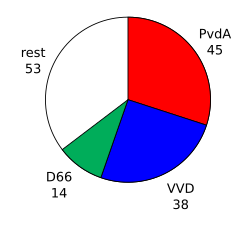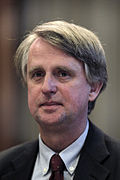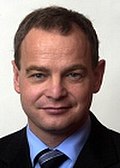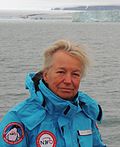Second Kok cabinet Second Purple cabinet | |
|---|---|
| Cabinet of the Netherlands | |
 The installation of the second Kok cabinet on 3 August 1998 | |
| Date formed | 3 August 1998 |
| Date dissolved | 22 July 2002 (Demissionary from 16 April 2002) |
| People and organisations | |
| Head of state | Queen Beatrix |
| Head of government | Wim Kok |
| Deputy head of government | Annemarie Jorritsma Els Borst |
| No. of ministers | 15 |
| Ministers removed | 2 |
| Total no. of members | 17 |
| Member party | Labour Party (PvdA) People's Party for Freedom and Democracy (VVD) Democrats 66 (D66) |
| Status in legislature | Centrist majority grand coalition |
| History | |
| Election | 1998 election |
| Outgoing election | 2002 election |
| Legislature terms | 1998–2002 |
| Incoming formation | 1998 formation |
| Outgoing formation | 2002 formation |
| Predecessor | First Kok cabinet |
| Successor | First Balkenende cabinet |
The second Kok cabinet, also called the second Purple cabinet, was the executive branch of the Dutch government from 3 August 1998 until 22 July 2002.
Contents
The cabinet was a continuation of the previous first Kok cabinet and was formed by the social-democratic Labour Party (PvdA), the conservative-liberal People's Party for Freedom and Democracy (VVD) and the social-liberal Democrats 66 after the election of 1998. The cabinet was a centrist grand coalition and had a substantial majority in the House of Representatives with Labour Leader Wim Kok serving as Prime Minister. Prominent Liberal politician Annemarie Jorritsma, the Minister of Transport and Water Management in the previous cabinet, served as Deputy Prime Minister and Minister of Economic Affairs, while former progressive-liberal leader Els Borst continued as Minister of Health, Welfare and Sport and also served as Deputy Prime Minister.
The cabinet served during the economic expansion of the late 1990s and early unstable 2000s. Domestically, it was able to implement several major social reforms such as legalising same-sex marriage, and had to deal with the assassination of Pim Fortuyn. Internationally, it had to deal with several crises such as the fallout of the Srebrenica massacre and the response to September 11 attacks. The cabinet suffered several major internal and external conflicts including multiple cabinet resignations; the cabinet itself resigned prematurely on two occasions: first following a major political crisis in May 1999 (it later came back on its resignation), and second, following the conclusions of a report into the Srebrenica massacre on 16 April 2002. It continued in a demissionary capacity until it was replaced following the election of 2002. [1] [2]

































